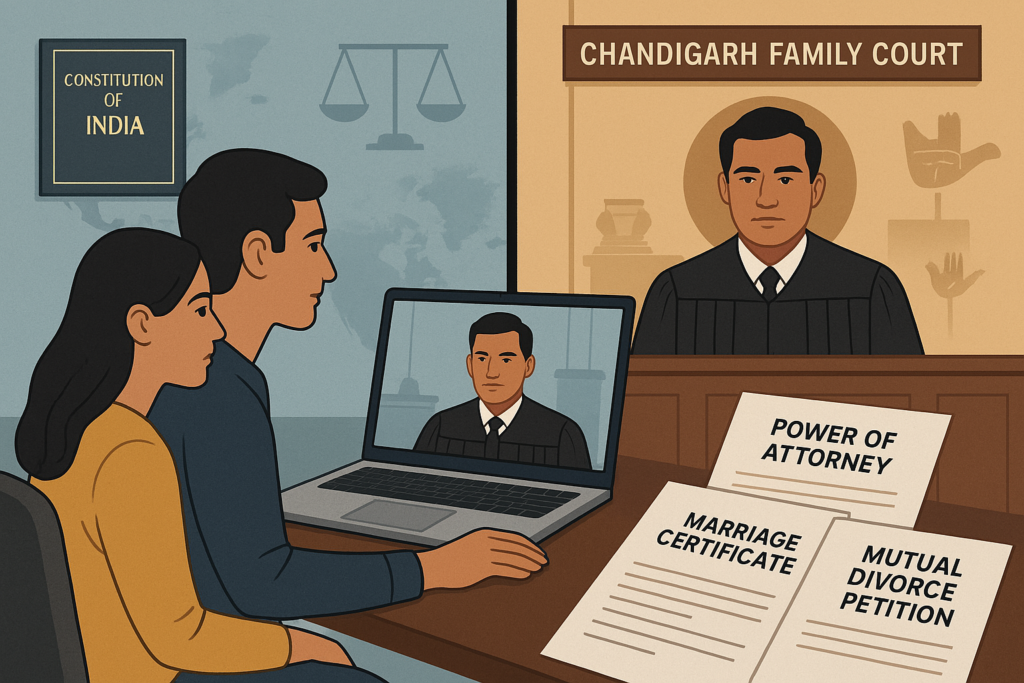Can I Get a Mutual Divorce Without Court Appearance in Chandigarh? This is a frequently asked question by Non-Resident Indians (NRIs), overseas professionals, and estranged spouses who cannot be physically present in India but wish to legally dissolve their marriage. With the evolution of Indian family law, the answer is: yes, it is legally possible—under certain conditions.
This article provides an in-depth explanation of how mutual divorce without physical court appearance is processed in Chandigarh. It covers the relevant laws, required legal documentation, court discretion, Power of Attorney mechanisms, and modern developments such as video conferencing. The content is structured to be informative, accessible, and practical for clients and legal students, and it includes essential keywords like family advocates in Chandigarh, high court lawyers in Chandigarh, and matrimonial dispute lawyers in Chandigarh.
Legal Foundation of Mutual Divorce in India
Mutual Divorce under Hindu Marriage Act, 1955
For Hindus, Sikhs, Buddhists, and Jains, Section 13B of the Hindu Marriage Act, 1955 provides the statutory framework for divorce by mutual consent. It consists of two key stages:
- Section 13B(1): Filing of the first motion by both parties, affirming mutual agreement to divorce after at least one year of separation.
- Section 13B(2): After a six-month cooling-off period, the second motion is filed to finalize the divorce.
Mutual Divorce under Special Marriage Act, 1954
For couples of different religions or civil marriages, Section 28 of the Special Marriage Act, 1954 governs mutual divorce. It mirrors Section 13B, with similar procedural steps and requirements.
Divorce for Christians
Under the Indian Divorce Act, 1869, Section 10A allows Christian couples to file for mutual consent divorce after one year of marriage and one year of separation.
These laws form the backbone for mutual divorce proceedings across Indian courts, including Chandigarh Family Court.
Is Physical Court Appearance Mandatory for Mutual Divorce?
The legal position has evolved, especially with the increased use of Power of Attorney (POA) and video conferencing technologies. Courts, including those in Chandigarh, are more flexible, particularly in mutual consent divorce proceedings.
Relevant Judgments Supporting Non-Appearance
1. Amardeep Singh v. Harveen Kaur (2017) 8 SCC 746
The Supreme Court held that the six-month cooling-off period under Section 13B(2) is not mandatory but directory. If the parties have settled all issues amicably, the court can waive this period.
2. Krishna Veni Nagam v. Harish Nagam (2017) 4 SCC 150
The court recognized the possibility of video conferencing for parties unable to attend hearings in person, especially in matrimonial cases.
3. K Srinivas Rao v. D.A. Deepa (2013) 5 SCC 226
The court emphasized the importance of minimizing emotional trauma and litigation burden in divorce proceedings, supporting alternative and streamlined procedures.
Mutual Divorce Without Appearance in Chandigarh: Legal Pathway
Filing Through Power of Attorney
What is Power of Attorney (POA)?
A Power of Attorney is a legal instrument authorizing someone else—often a family lawyer in Chandigarh or a trusted relative—to act on your behalf in legal proceedings.
Key Requirements:
- Must be executed in the foreign country where the NRI or absent party resides.
- Must be notarised and apostilled or attested by the Indian Embassy or Consulate.
- Clearly authorise the attorney to file, represent, and sign affidavits in the divorce case.
Appearance Via Video Conferencing
Chandigarh Family Court, like many other courts in India, may permit video conferencing in mutual consent matters. Courts take a lenient approach when both parties:
- Have no dispute over issues like maintenance, alimony, and custody.
- Submit affidavits affirming consent.
- File a joint application seeking permission for video appearance.
This is especially common in cases involving NRIs or individuals with health constraints, visa issues, or employment abroad.
Procedural Steps for Mutual Divorce Without Appearance in Chandigarh
Step 1 – Engage a Family Advocate in Chandigarh
Appoint a qualified family advocate in Chandigarh or a matrimonial dispute lawyer in Chandigarh to handle the case. The lawyer will prepare all necessary documents and guide the parties.
Step 2 – Execute Power of Attorney
The absent spouse must:
- Draft a Power of Attorney explicitly for divorce proceedings.
- Get it notarised and apostilled or attested by the nearest Indian mission.
- Send the original to the attorney in India.
Step 3 – Filing the First Motion
The petition is filed in the Chandigarh Family Court under Section 13B of HMA or the applicable Act. One spouse appears in person (or through a POA holder); the other may appear via video or through POA.
The court records statements and may issue the first motion order.
Step 4 – Cooling-Off Period and Waiver Application
By default, the parties must wait six months. However, this can be waived by filing an application, if:
- Parties have lived separately for over a year.
- All terms of settlement are finalized.
- There are no pending disputes.
Step 5 – Second Motion and Decree
Upon satisfaction, the court may accept final statements from both parties—either in person, through POA, or via video link—and grant the decree of divorce.
Can Both Spouses Be Absent Physically?
Yes, it is possible if both:
- Submit affidavits affirming consent.
- Provide valid POAs authorizing legal representatives.
- Request virtual appearance or exemption from personal appearance due to valid reasons.
Courts exercise discretion based on the merits, nature of settlement, and sincerity of the parties. While courts prefer physical appearance, it is not legally mandatory in mutual divorce cases under certain conditions.
Additional Considerations for NRIs and Non-residents
Documentation Checklist:
- Marriage certificate
- Address and ID proof
- Separation proof (if available)
- Settlement agreement (if applicable)
- Power of Attorney (apostilled)
- Passport copies of both parties
Role of Lawyers in Chandigarh
- Family lawyers in Chandigarh help file petitions, liaise with the court, and draft all necessary documents.
- High court advocates in Chandigarh can assist with appeals or if any interim orders are challenged.
- Matrimonial dispute lawyers in Chandigarh ensure amicable settlement of child custody, maintenance, and property issues.
Importance of Court Discretion
Although mutual consent divorce is supposed to be streamlined, the judge has the final discretion on allowing absence or remote participation. Hence, the conduct of the parties, clarity of documents, and thorough representation by competent advocates in Chandigarh is crucial.
The question “Can I get a mutual divorce without court appearance in Chandigarh?” is increasingly relevant in today’s global context. With evolving technology, supportive Supreme Court judgments, and flexible court procedures, mutual divorce without physical presence is legally permissible—when done correctly.
By appointing a valid Power of Attorney, submitting proper documents, and working with competent family advocates in Chandigarh, parties can obtain divorce orders without returning to India. Courts consider such petitions with empathy, provided the intent is genuine and mutual.
Whether you are an NRI, a professional living abroad, or simply unable to attend court due to health or personal reasons, Indian law—especially in jurisdictions like Chandigarh—provides a structured path for a hassle-free, legally sound mutual divorce without in-person court appearance.
FAQs on Can I Get a Mutual Divorce Without Court Appearance in Chandigarh
- Can I get a mutual divorce in Chandigarh without attending court in person?
Yes. Courts in Chandigarh may allow mutual divorce without personal appearance if you execute a valid Power of Attorney or appear via video conferencing. Your lawyer must file the necessary applications and supporting documents. - What if both spouses live abroad?
If both spouses are NRIs or live outside India, they can file for divorce through their POA holders in Chandigarh and appear virtually. Many family advocates in Chandigarh handle such matters regularly with court approval. - Is the six-month waiting period always necessary?
No. The Chandigarh Family Court can waive the six-month period if both parties agree on all issues and submit an application stating the separation has already lasted over a year. - What if the judge still insists on personal appearance?
In rare cases, judges may require one or both parties to attend physically, especially if they suspect coercion or incomplete disclosure. In such situations, high court lawyers in Chandigarh can help file a writ or revision petition. - Which professionals should I consult for mutual divorce without appearance?
You should consult experienced family lawyers in Chandigarh, matrimonial dispute lawyers in Chandigarh, or high court advocates in Chandigarh who are well-versed in divorce procedures and exemptions permitted under Indian law.

